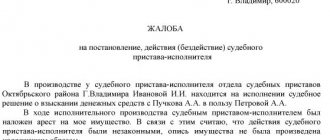Failure to pay any type of debt often results in a lawsuit. Moreover, it is necessary not only to win the trial, but also to recover the amount due from the defendant. According to statistics, the latter rarely do this on a voluntary basis. The plaintiff’s submission of a writ of execution to the Bailiff Service (FSSP) will help to finally resolve the material conflict. In rare situations, the judicial authority does this on its own.
When is an application required?
Sometimes the plaintiff does not know how to submit a writ of execution to the bailiffs. A citizen must apply to the FSSP if necessary:
- Forcibly seize the debtor's property.
- Oblige the evader to pay cash.
- Locate a person.
- Etc. according to the executive document.
Typically, the following groups of persons act as collectors in these cases:
- Banking industry employees (if the borrower does not pay the principal debt, fines or penalties on it).
- Women who are divorced and have young children in their care (if the ex-husband does not provide financial assistance in the form of alimony).
- Individuals (when it is necessary to search for a child).
- Citizens who were illegally evicted from their occupied area (in order to be forced to resettle them back).
- Workers whose contract was terminated without legal grounds.
In the latter case, the bailiff may request the applicant's autobiography and attach it to the materials available in the case.
How installment plans are provided - a sample application to the court
To ask for payment of a debt in installments, an individual needs to go to court. The application is submitted to the court that made the decision, or to the district court at the place of execution (in the same area where the bailiffs department is). The debtor himself or the bailiff has the right to ask the court to pay in installments if he sees that the person has nothing to pay. There is no state fee for filing an application.
Sample application to the court for installment payment to the FSSP - 18 KB
- An application to the court for installment payment is drawn up in several copies: for the court, bailiffs, creditor and all interested parties (if there is, for example, a guarantor).
- The header of the document contains the details of the judicial authority, the applicant, information about the court decision and debt.
- The reasons that do not allow you to repay the debt are indicated: illness, presence of dependents and difficult financial situation, dismissal, reduction in income.
All circumstances are documented: attach medical certificates, birth/death certificate, loan agreements, document confirming disability, dismissal order. The legislation allows the involvement of witnesses who are able to confirm the financial problems of the debtor. - A request is indicated to allow the debt to be repaid in feasible payments, as well as the term and terms of the installment plan (number of months, exact amount of the monthly payment). You need to independently develop a schedule of mandatory payments and attach it to the application.
When considering the application, the court will assess the situation and take into account the evidence. After making a decision on installment payment, the bailiffs, when working with an individual, will be guided by the established schedule for repaying obligations. If the debtor follows the court decision, he will not have additional problems with the FSSP.
They arise when payment is received in a smaller amount than the payment amount fixed in the schedule, or when payment terms are violated. Then the bailiffs will be able to re-raise the issue of forced collection of the debt and will go to court to cancel the order on installment payments.
Procedure for drawing up an application
You can find out where to submit the writ of execution on the official Internet resource of the Bailiff Service - fssprus.ru. The filing of an application addressed to the FSSP bailiff is carried out in accordance with the established procedure.
The “header” (upper corner of the sheet on the right) contains the following information:
- Information about the addressee (full name, position).
- Information about the applicant (full name, place of residence, contact details).
The descriptive part must indicate the essence of the statement. As a sample, you can consider an application to bailiffs for the collection of alimony. Then the text should indicate:
- Information about the court decision issued.
- Information about the child (children) for whose support funds are being collected.
- Account details for transferring financial assistance.
The final stage is a list of attached documents (original court decision, account details, etc.), date and signature of the applicant.
To ensure that the application to the bailiff service is written correctly, it is better to use the established form. The document will be accepted and recorded in the appropriate journal on the same day. Sample application to bailiffs:
Enforcement proceedings for dummies. First acquaintance with the bailiff service.
The lengthy trial is over, and you finally have a writ of execution in your hands, which you can present to the bailiff service for enforcement. Now you have turned from a plaintiff into a claimant.
First of all, having received a writ of execution in court, be sure to check the presence of all the necessary details, which are contained in Article 13 of the Federal Law “On Enforcement Proceedings” (hereinafter referred to as the “Law”).
In the event that some details are not in the writ of execution, you can rest assured that the bailiff will refuse to initiate enforcement proceedings on the basis of clause 4 of Art. 31 of the Law.
Most often, in practice, the year of birth of the debtor, the place of birth of the debtor is not indicated, or the place of birth of the debtor is indicated incompletely (for example, Moscow region, Moscow district - without indicating a specific locality). In case of incomplete indication of the place of birth, the bailiff considers that this mandatory detail is not indicated in the enforcement document.
It is recommended that when receiving a writ of execution in court, you check all its necessary details (I quote Article 13 of the Law):
1) the name and address of the court or other body that issued the executive document, the surname and initials of the official;
2) the name of the case or materials on the basis of which the executive document was issued, and their numbers;
3) the date of adoption of the judicial act, act of another body or official;
4) the date of entry into force of a judicial act, an act of another body or official, or an indication of immediate execution;
5) information about the debtor and claimant:
a) for citizens - last name, first name, patronymic, place of residence or place of stay, and for the debtor also - year and place of birth, place of work (if known);
b) for organizations - name and legal address;
c) for the Russian Federation, a subject of the Russian Federation or a municipality - the name and address of the body authorized on their behalf to exercise rights and perform duties in enforcement proceedings;
6) the operative part of a judicial act, an act of another body or official, containing a requirement to impose on the debtor the obligation to transfer funds and other property to the claimant, or to perform certain actions in favor of the claimant or to refrain from performing certain actions;
7) date of issue of the writ of execution.
In practice, questions may arise about subparagraph “b”, part 5 of Article 13 of the Law - the requirement to indicate the legal address.
The legislation does not contain such a concept as a legal address, but uses the term location of a legal entity. In order not to bother yourself, you need to know that the writ of execution must simply indicate the address of the legal entity, and what it is called, legal, actual or postal, has no practical meaning.
A very useful and important innovation of the Law is the ability of the claimant independently present a writ of execution for the collection of periodic payments (for example, alimony), as well as any other writ of execution for the collection of an amount not exceeding 25 thousand rubles. directly to the organization where the debtor receives wages, pension or other periodic income.
This innovation allows you to:
— the claimant promptly receives what is collected according to the writ of execution. For example, you know the debtor’s place of work. Now there is no need to “hand over” the writ of execution for the collection of alimony to the bailiff in order for him to forward it for retention to the debtor’s place of work;
- eliminates the ineffective workflow for researching the debtor’s property status by a bailiff (sending requests to registration authorities, foreclosure on property), which should have been undertaken earlier before sending a writ of execution for deduction from the debtor’s earnings (with the exception of collection of periodic payments).
Imagine this situation. Through the court, you recovered 10 thousand rubles from the debtor. Your debtor works at Russian Credit Bank.
Obviously, the debtor has wages. You present a writ of execution to the bank with your application, in which you ask the bank to deduct from the debtor 50% (the maximum amount of deductions) of his income. It is very likely that you will receive your ten thousand in one deduction. The writ of execution must be submitted to the organization by courier (i.e., against signature by the secretary of the organization or directly to the head), or by registered mail with notification.
As in the previous edition, the claimant, in accordance with Art. 8 of the Law, you have the right to send a writ of execution to the bank. This method is effective and is used in practice if your debtor is an existing legal entity and conducts financial and economic activities.
It is important to note that the collector does not need to know the specific current account number; it is enough to know only the bank where the debtor’s current account is located.
Simultaneously with the writ of execution, the claimant submits to the bank an application in which he indicates: - details of the claimant's bank account to which the collected funds should be transferred; - last name, first name, patronymic, citizenship, details of an identity document, place of residence or place of stay, taxpayer identification number (if available), details of the migration card and document confirming the right to stay (residence) in the Russian Federation of the claimant-citizen; - name, taxpayer identification number, state registration number, place of state registration and legal address of the claimant - a legal entity.
In this case, drawing up a collection order for legal entities (if the collector is a legal entity) is not required; one application is sufficient (clause 2 of Article 70 of the Law).
The bank forecloses on funds in the manner prescribed by Art. 70 of the Law. In accordance with paragraph 5 of Art. 70 of the Law, within three days from the date of receipt, the bank fulfills the requirements and, if there are insufficient funds, the bank continues to fulfill as received until full repayment.
The bank stops execution only in three cases (clause 10, article 70 of the Law): - after transferring funds in full; - at the request of the claimant; - by order of the bailiff on termination (completion, cancellation) of execution.
The issue of foreclosure on funds will be discussed in more detail below.
Also, the claimant always has the unconditional right to present a writ of execution to the bailiff without first going through the procedures described above.
To whom and how to send a writ of execution for enforcement? Bailiffs carry out their activities on a territorial basis, namely at the place of residence of the debtor.
That is, the writ of execution, as a general rule, must be presented to the territorial department that serves the area in which the debtor lives. For example, the debtor lives in the Leninsky district of Tver, the writ of execution must be presented to the Leninsky territorial department of bailiffs of Tver.
The same should be done if the debtor is a legal entity. In the event that you want to present a writ of execution at the location of a branch of a legal entity and the address of this branch is not contained in the writ of execution, you must attach evidence of the existence of such a branch at the specified address (this method of presentation is relevant when collecting from insurance companies, banks, and other organizations with a multi-branch network throughout the Russian Federation). Otherwise, the initiation of enforcement proceedings will be refused.
In accordance with Art. 33 of the Law “Place of execution of enforcement actions and application of enforcement measures,” the claimant has the opportunity to present a writ of execution at the location of the debtor’s property.
It is advisable to do this if most of the debtor’s property, especially real estate, is located at a remote distance from the debtor’s place of residence. The presence of the debtor's property in another territory must be indicated in the application to initiate enforcement proceedings and the relevant evidence must be attached (for example, a copy of the certificate of state registration of rights to real estate, etc.). Otherwise, the clerks of the territorial departments of the bailiffs will “kick you off at the authorities,” and the initiation of enforcement proceedings may be refused.
If we are talking about the fulfillment of requirements to perform certain actions (for example, “... oblige A.P. Ivanov not to interfere with the use of the water supply system located at such and such an address...”), then the writ of execution must be presented at the place where these actions were performed. This must also be indicated in the application to initiate enforcement proceedings. Initiation of enforcement proceedings is possible only on the basis of a written application from the claimant or his representative.
The powers of the representative are formalized in the usual manner - by a power of attorney, but it is important to note one feature - in the power of attorney, in addition to the usual powers of the representative, the power to present a writ of execution for execution must be specifically stipulated.
This requirement is contained in paragraph 3 of Art. 57 of the Law “Powers of representatives of parties to enforcement proceedings”. The following powers of the representative in enforcement proceedings must also be specifically stipulated: - presentation and withdrawal of the enforcement document; — transfer of authority to another person (subassignment); — appealing decisions and actions (inaction) of the bailiff; — receipt of awarded property (including cash and securities); — refusal of collection under a writ of execution; - conclusion of a settlement agreement.
The power of attorney (and not its copy - clause 2 of Article 30 of the Law) is attached to the application to initiate enforcement proceedings. An example of an application to initiate enforcement proceedings is given in the appendix.
It is useful in an application to initiate enforcement proceedings to request the seizure of the debtor’s property in order to ensure compliance with the requirements of the enforcement document. This will allow the bailiff to seize the debtor’s property, incl. within the period established for voluntary execution by the debtor, immediately simultaneously with the delivery of the resolution to initiate enforcement proceedings.
In addition, you can indicate the application to the debtor of a temporary restriction on leaving the Russian Federation (Article 67 of the Law). By the way, this enforcement action is traditional for Russian legislation, so in pre-revolutionary law, the bailiff could prohibit the debtor from leaving his place of residence (and not the borders of the Russian Empire in general - author’s note)
If you have any valuable additional information about the debtor, then it must be indicated in the application to initiate enforcement proceedings. It is even better if it is possible to draw up a joint action plan with the bailiff, and also if you have the opportunity to assist the bailiff in carrying out enforcement actions and applying enforcement measures (providing vehicles for transporting seized property, storage space for property, loaders, etc.). The likelihood of quick and complete compliance with the requirements of the writ of execution in such cases increases significantly.
The collector must always remember one simple thing - his role in debt collection must be extremely active.
If you are a debtor , then you also need to know several important rules. Every debt is returned ®. The natural course of things is that the debtor is not eager to pay the debt, otherwise the matter would not have reached the bailiffs. There are cases when the debtor takes a principled position not to pay, because considers the court's decisions illegal and unfair. This category of debtors is the most difficult for a bailiff.
The simplest tactic that a debtor can choose is the tactic of passive defense. What is it? Do not receive correspondence, do not open the door to the bailiff, hide, “transfer” all property to other persons.
However, the use of this tactic is effective only at some stage. The new version of the law on enforcement proceedings has closed many loopholes for the debtor.
Chapter IV of the Law “Notification and Summons in Enforcement Proceedings” contains a set of legal norms that makes the tactic of not receiving correspondence ineffective. In accordance with clause 3. Art. 24 of the Law, the notice is sent to the address indicated in the enforcement proceedings or at the place of work.
That is, if the debtor is officially employed, then he will not be able to avoid receiving correspondence. In case of evasion of appearing when called, the debtor may be forcibly brought in (you must agree that this is an unpleasant procedure when you are “led away” by people in uniform in the presence of work colleagues).
If the debtor changes his place of residence, he is obliged in accordance with Art. 28 of the Law, inform the bailiff department about the change of your address. If there is no such message, then all correspondence is sent by registered mail to the last known address of the specified person, and he is considered notified, even if he no longer resides or is located at this address.
A person participating in enforcement proceedings (including the debtor), in accordance with paragraph 2 of Art. 29 of the Law, is considered notified if: - the addressee refused to receive a summons or other notice; - despite receiving a postal notice, the addressee did not appear for a summons or other notice sent to his address.
That is, during enforcement proceedings, receiving correspondence is the debtor’s problem, and if he simply does not receive it, then this does not give him any advantages.
“Rewriting” the property of other persons, of course, makes it impossible to foreclose on it. However, here the debtor receives another group of risks - how reliable are the persons to whom the property is re-registered. In practice, there are cases when people thus gave away their property for nothing.
In addition, at present, bailiffs are actively using procedures to recognize transactions for “rewriting” property as invalid (imaginary).
I once covered this issue in the article “Dispossession of property in enforcement proceedings,” which can be found, for example, at this link
Application
In Leninsky (Frunzensky, etc.) ROSP, Moscow st. Bagaeva, 27
from Ivanov Ivan Ivanovich
living Moscow st. Ivanovskaya 1, apt. 1
Application for initiation of enforcement proceedings
I ask you to accept for forced execution the writ of execution issued on the basis of the decision of the Leninsky District Court of Moscow dated January 1, 2001. in case No. 1-11, about the recovery from the debtor Petrov Petr Petrovich, living at the address: Moscow, st. Petrovskaya, 1, apt. 1, a sum of money in the amount of 1000 rubles in my favor, and initiate enforcement proceedings.
Simultaneously with the initiation of enforcement proceedings, I request that the debtor’s property be seized in order to ensure compliance with the requirements of the enforcement document.
Date 01/01/2010 ________________________ (Ivanov I.I.)
Note
1. The writ of execution is presented by the claimant. In this case, the person accepting the writ of execution verifies the identity of the presenter by checking identification documents (passport; for military personnel - identity card). Driver's licenses and various types of identification documents are not identification documents.
2. In the case of presentation of a writ of execution by a representative of the claimant, it is necessary to have a genuine power of attorney drawn up in accordance with current legislation.
Unlock access to the private part of Clerk with a Premium subscription. Get hundreds of webinars and online courses, unlimited consultations and other proprietary content for accountants.
Hurry up to subscribe with a 20% discount until October 15, 2021. Read more about “Premium” here.
Submission order
An application to bailiffs for a writ of execution is submitted in the amount of 2 pieces. One copy will be marked with an acceptance mark indicating the date and registration number of the application.
A bailiff in the specified case is appointed within 3 days from the date of submission of documents (in accordance with Federal Law No. 229). After 3 working days, he must initiate enforcement proceedings, for which a resolution is drawn up. A copy is sent to the following persons:
- To the claimant.
- To the judiciary.
- The defaulter, thereby giving him the opportunity to pay off his debts within 5 working days.
Sometimes the bailiff does not formalize enforcement proceedings within the required period. In this case, you can report the violation to senior management (senior bailiff). Read about how to correctly write an application for a bailiff.
If the applicant cannot appear at the FSSP on his own, the application may be sent by registered mail. To avoid problems in the future, it is better to keep the return notification confirming delivery of the application. It is mandatory to send a corresponding request to the Bailiff Service when changing your place of residence.
Deadlines for applying for a writ of execution
The law does not provide for a time limit for receiving a writ of execution by the plaintiff: you can apply the next day after the decision comes into force, or a month or two later - but the date of commencement of enforcement proceedings by bailiffs depends on this.
In cases where a writ of execution is needed urgently, the application should be written as early as possible and submitted on the day the court decision comes into force. Also, to speed up the process, you can regularly call the office and ask if the document is ready.
Sample complaint about red tape when issuing a writ of execution
It should be remembered that the office has no reason to delay the issuance of the document too much (more than 30 days). If you think that the office is deliberately delaying the issuance process, you should write a complaint to the chairman of the court about the red tape when issuing the writ of execution.
Total
The service where the bailiff operates works in compliance with certain stages of the process provided for by Federal Law 229, checking the debtor's property and forcing him to pay his debts before the case goes into the data bank as closed. Each of them has certain specifics and a set of actions that are expected from specialists. If enforcement proceedings are suspended or terminated, this action can be said to be legal if it has grounds and does not contradict the law. If the bailiff does something unlawfully, his actions must be challenged. To do this, you can contact a higher authority or court. Especially if you were included in the list of debtors by mistake, and you are not going to comply with the instructions that were sent to you illegally.
You can get legal assistance on issues of enforcement proceedings on our website.
Rights of the debtor in FSSP proceedings
Having lost the court, the debtor is obliged to voluntarily comply with the decision. In practice, the collection process can drag on for months and years, especially if the debtor is hiding from the bailiff, does not work, or does not have a stable source of income.
In relation to unscrupulous debtors, the bailiff can take such measures as initiating criminal or administrative cases, arrest and sale of property, imposing a ban on foreign travel, and deprivation of a driver’s license.
In some cases, even a conscientious debtor cannot pay the entire debt at once. The reason for this may be various life circumstances: from job loss and reduced earnings to disability, long-term and serious illness.
To protect his interests, the debtor may take advantage of the following rights:
- ask the bailiff to postpone enforcement actions for up to 10 days;
- go to court to delay or install payments;
- apply for a reduction in the amount of the enforcement fee, if there are such grounds;
- apply for an executive holiday if the debtor qualifies for this program;
- appeal illegal decisions and actions of the FSSP specialist;
- continue appealing the judicial act to higher authorities.
If the debtor's situation falls under the criteria of bankruptcy, you can exercise the right to write off debts. Note that in bankruptcy you can also get debt payment in installments. This is allowed when introducing a restructuring procedure or drawing up a settlement agreement with creditors. But such options do not provide for debt write-off, since the citizen assumes obligations to make voluntary payments to creditors.
How to write and resubmit correctly
An application to initiate enforcement proceedings is submitted before the end of the established deadlines. And it is also allowed to re-submit an appeal if the plaintiff’s earlier demands were not satisfied in full, including for the following reasons:
- In case of refusal to initiate. It is advisable to resubmit the application after eliminating the reasons for the refusal.
- Collection from the debtor has not been made in full.
Submission of a repeated application must occur no earlier than the established deadlines:
- 6 months if there is a court decision to withhold periodic payments from the debtor (alimony, other debts);
- 2 months under other circumstances.
Site Expert
Beloborodova Yulia
From 2004 to 2012 she worked as a bailiff. Specializes in the field of procedural, civil, financial, family and labor law.
Ask a Question
If the plaintiff knows information about the improvement of the debtor’s financial situation, then there is no need to wait for the end of the established deadlines.
Example of a return visit or appeal
The requirements for drawing up an application are also relevant for repeated applications to initiate enforcement proceedings. You should also present a court decision, indicate known information about the financial situation of the defendant and his location.
Articles:
In what cases can one refuse to initiate enforcement proceedings?
Sample application for acceptance of a writ of execution for execution










